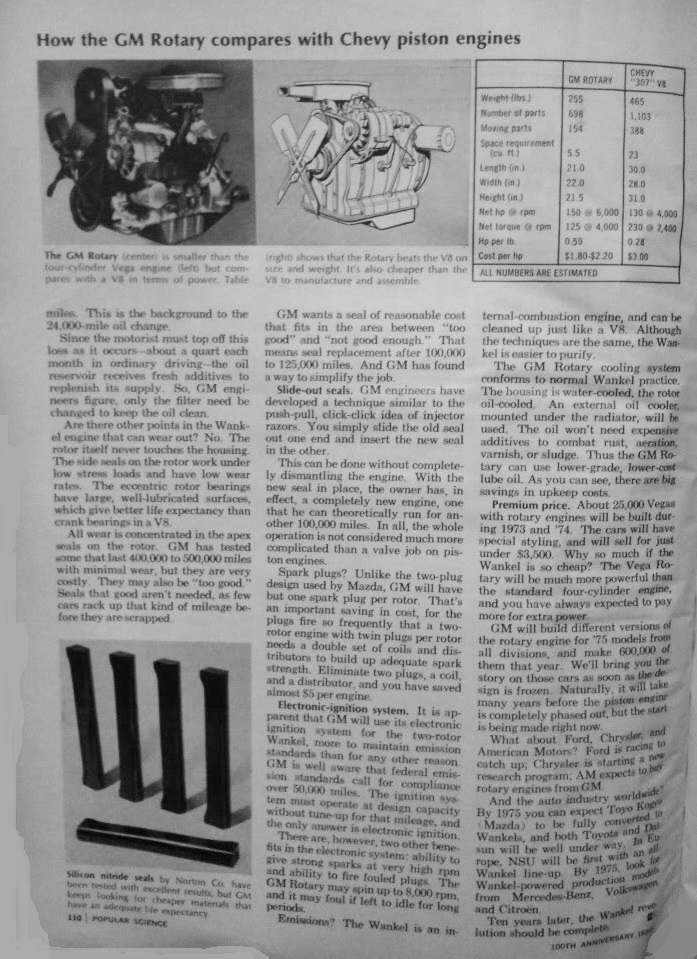-
VAUXHALL - ROTARY ENGINE
PROJECT

The General Motors Rotary Combustion Engine (GMRCE) was the project
name given to the engineering work carried out on the Wankel engine
which uses a rotary design to convert pressure into a rotating
motion instead of using reciprocating pistons. Several NSU and
Mazda rotary engines were procured in the late 1960s by GM Advanced
Engineering Division and stripped down and analysed for viability
versus conventional piston engines. The initial results were
promising due to the huge savings in weight and engine refinement.
As a result of these preliminary findings GM paid $50m for an
initial license to
produce their own version of the rotary engine. GM president Ed
Cole initially projected a commercial release within three years –
later to be seen as a very rash statement. Chevrolet were the lead
division with Pete Estes, John DeLorean and Cole all giving their
support for the project. A highly experienced engineer Bob Templin
was made the chief executive in charge of rotary-engine research at
the GM Tech Centre in Warren Michigan but Ed Cole would leave his
office in Detroit twice a week for the trip to Warren so he could
take chrge and minitor the progress of the programme. The engine
was initially targeted for an October 1973 introduction in the 1974
Chevrolet Vega as an engine option or standard in a sports
version.

THE COVER OF POPULAR SCIENCE MAGAZINE WHICH MADE BOLD PREDICTIONS
FOR THE FUTURE OF GENERAL MOTORS ROTARY ENGINE - WHICH WERE ALL
WRONG IN THE END!
Further publicity was given in Popular Science magazine in May 1972 with an article titled “GM Rotary Engine for the 1974 Vega" complete with an illustration of the Wankel installed in a 1974 Vega hatchback using a different grille, a lower, more sloped hood line, and a "GM Rotary" badge and Wankel crest on the rear quarter panel. It was stated the Vega-rotary would be sold as a package with performance items, including mag-styled wheels, radial tires, and rally stripes. In durability tests the Wankel had so far proven more reliable than four, six, and eight-cylinder engines – GM-rotary engines were run up to 500,000 miles (800,000 km) showing only minimal wear, and the engine's fewer moving parts assured its reliability. The final design General Motors Rotary Combustion Engine (GMRCE) was fixed when responsibility for the power plant's manufacture was turned over to General Motors Hydra-Matic Division in August 1972 – two rotors displacing 206 cubic inches, twin distributors and coils, and a switch to aluminium housing construction. Iron couldn't match the heat-dissipating qualities of aluminium. In addition, there was also a rotor tip-seal problem in the cast-iron



configuration, especially after 15,000 miles. RC2-206 Wankel
engines were installed in 1973 Vegas for cold weather testing
performed in Canada. To assist with development it was at this time
that Vauxhall were made the lead division for rotary engine
research for all overseas divisions outside North America.
Considerable studies and evaluation exercises in conjunction with
Chevrolet were done at Vauxhall’s Engineering Centre at Luton using
modified NSU Wankel engines in the late 1960s and then experimental
GM RC2-206 rotary engines in the early 1970s. Initial development
was aimed at meeting European emission standards which at the time
were lower than the US combined with acceptable fuel economy and
was in hand when GM decided to defer the project in late 1974 — the
same time that they decided to drop production plans at Chevrolet
and centralise rotary technology at GM Engineering Staff because of
the oil crisis. A number of these GM RC2-206 rotary engines were
installed in Vauxhall cars, one in a manual Firenza and two in FE
Ventora automatics. GM in the US carried on developing the rotary
in diesel, stratified charge and fuel injected form, but it still
had a five or six per cent fuel economy penalty compared with a
conventional spark ignition reciprocating
engine.







